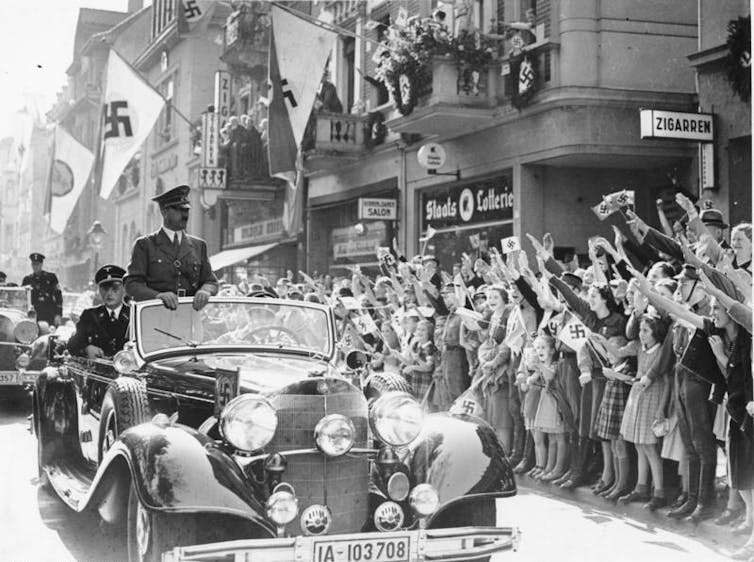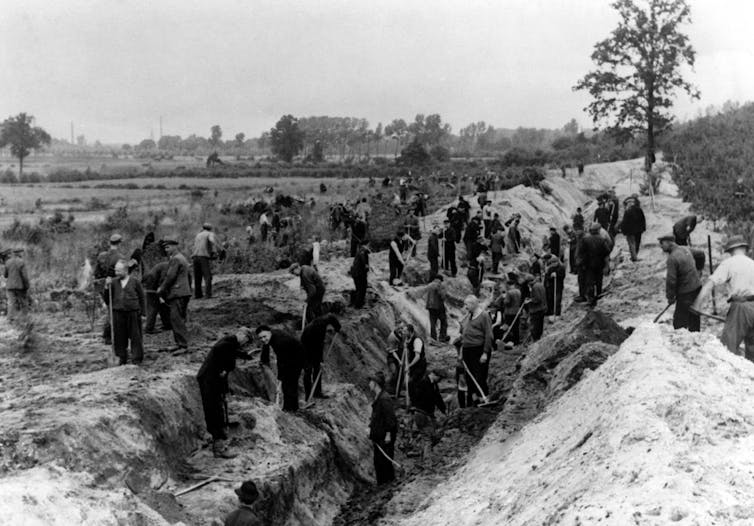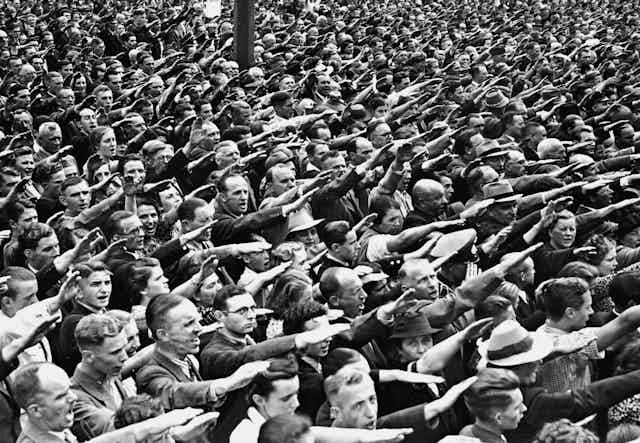In the initial post-war judicial proceedings to establish what had happened under Nazism, and to punish the perpetrators of crimes, victims’ accounts were often discredited. Only in 1961, with the high-profile trial of Nazi war criminal Adolf Eichmann in Jerusalem, did the focus shift.
For many survivors, the concept of “Holocaust testimony” – accounts of what they had lived through – took on almost sacred dimensions. In 1989, author and Auschwitz-survivor Elie Wiesel argued that it was unethical for anyone besides surviving victims of the Holocaust to try to represent or explain it.
In some ways, Wiesel’s insistence that only surviving victims could really “know” the Holocaust has contributed to the mystification of this historical period. Holocaust deniers have misappropriated this very process to their own ends.
Examining contemporary non-victims’ perspectives can help us to understand the violence perpetrated as, in part, the result of social systems. My research explores how accounts by anti-Nazi refugees were received (in translation) by British readers at the time.
Such memoirs can illustrate the process by which Nazism transformed the German population into what historian Mary Fulbrook calls a “bystander society” – even before the conditions of wartime normalised acts of excessive violence.

Living in Nazi Germany
In 1939, Sebastian Haffner, whose real name was Raimund Pretzel, wrote a memoir titled Geschichte eines Deutschen. Die Erinnerungen 1914–1933 (Stories of a German. Recollections 1914-1933).
It was published after the author’s death in 2000, using the pen name under which he had become famous as a journalist in post-war West Germany. An English translation followed in 2003, titled Defying Hitler. Historian Dan Stone has described it as “among the more remarkable contemporary analyses of Nazism and the Third Reich”.
Haffner was a law trainee when Hitler took power. As the Nazi regime destroyed the democratic legal system he had studied, he took up journalism instead. His partner, Erika Schmidt-Landry, had been designated “Jewish” according to the Nuremberg race laws. When she became pregnant with Haffner’s child, the couple left Germany for England.
In the UK, Haffner started writing a memoir of his life so far, including his view of the rise of Nazism. In one telling scene, he describes how he felt when the Jewish colleagues in his law firm were forced out by Nazi storm troopers (AKA brown shirts) on April 1 1933, the day of the Jewish boycott. Some colleagues paced about nervously. Others sniggered. One Jewish colleague simply packed his bags and left.
Haffner writes:
My own heart beat heavily. What should I do? How keep my poise? Just ignore them, do not let them disturb me. I put my head down over my work. […] Meanwhile a brown shirt approached me and took up position in front of my work table. ‘Are you Aryan?’ Before I had a chance to think, I had said, ‘Yes.’ […] The blood shot to my face. A moment too late I felt the shame, the defeat. […] I had failed my first test. I could have slapped myself.
On another occasion, at a compulsory indoctrination camp for law students, Haffner is forced to perform the Hitler salute and sing pro-Nazi songs. He writes: “For the first time I had the feeling, so strong it left a taste in my mouth: ‘This doesn’t count. This isn’t me. It doesn’t count.’ And with this feeling I too raised my arm and held it stretched out ahead of me for about three minutes.”
Haffner’s account illustrates the self-deception and denial by which many people who did not actively support the Nazi regime survived within it. In an interview given in 1989, Haffner said it wasn’t that all Germans were Nazis but nor did Nazism hardly affect everyday life: “It was possible to live in a way alongside it.”

A bystander society
Fulbrook has shown how ordinary Germans were drawn into “processes of complicity”. Under Nazism, standing by as state-sponsored acts of collective violence were perpetrated gradually became the required norm. The personal risks of doing otherwise were very real. “What might be a morally laudable stance in a liberal, democratic regime,” Fulbrook writes, “may be, in other circumstances, both ineffective and potentially suicidal.”
If someone in the UK in 2024 judges German bystanders to Nazi crimes as “guilty” for not standing up for victims, they do so according to the moral obligations of a liberal democracy. Hitler’s ascension to power in 1933, however, had marked the end of German democracy. The Third Reich was a brutal police state. People were encouraged to denounce opponents to the regime. Defiance ran the risk of arrest, imprisonment or political “re-education” in a concentration camp under Schutzhaft (“protective custody”).
Both in Germany and across the international community, everyone had to understand the violence enacted under Nazism on their own terms. Even the words “genocide” and “Holocaust”, by which the era has since been defined, were not yet in people’s vocabulary.
The term “genocide” was coined by the Polish lawyer, Raphael Lemkin, in 1944 to describe the Nazis’ programme of Jewish destruction. “Holocaust”, a comparatively older word, only came to be widely used to formally describe the genocide perpetrated under Nazism against Jews from the late 1950s.
Further, racial segregation was also practised in other liberal democracies at the time. Jim Crow laws enforced racial segretation across the southern US states. The notion of racial hierarchy underpinned the British and other European empires.
Engaging with contemporary non-victims’ perspectives can help us to understand the violence perpetrated during the Holocaust as an effect of social systems. American literature and Holocaust studies scholar Michael Rothberg has argued for an approach to historical violence that considers the perspectives of “implicated subjects”.
Rothberg suggests the categories of heroes and villains, victims and perpetrators are inadequate in accounting for the harms done. Moving beyond them can also elucidate the destructive social dynamics of our own period.


